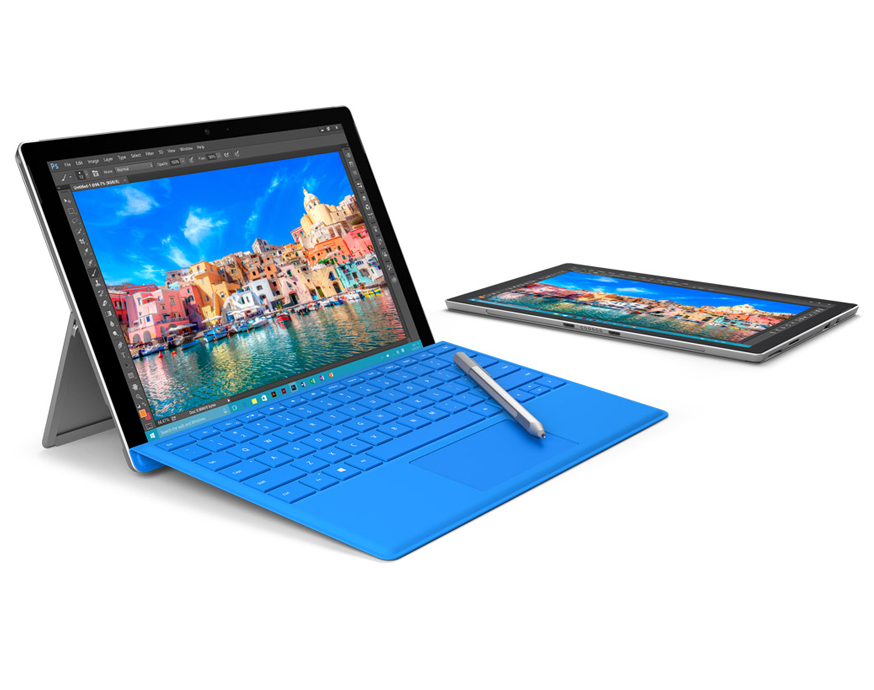 NEWS
NEWS
 NEWS
NEWS
 NEWS
NEWS
Microsoft yesterday took the wraps off the next generation Surface Pro, the tablet that can replace your laptop. The Surface Pro 4 is thinner, lighter and faster than its predecessor, the Surface Pro 3, and boasts a larger screen, is powered by sixth-generation (Skylake) Intel processors and has up to 1 terabyte of storage space.
Microsoft’s Surface Pro 3 mainly faced competition from Apple’s MacBook Air in the lightweight, ultra-portable laptop space but, thanks to the arrival of new two-in-one tablets like the iPad Pro and Google’s Pixel C, the Surface Pro 4 has a few new competitors to contend with.
Apple’s 12.9-inch iPad Pro is the biggest iPad to date and also the first to include an Apple-designed keyboard and stylus (Apple Pencil). Thanks to new multitasking features in iOS 9 and a number of third-party apps – including Microsoft’s Office Suite for iOS – adding functionality for the Apple Pencil, the iPad Pro promises to be a versatile and productivity-focused tablet that could stand-in for your laptop.
Also joining the hybrid party is Google’s 10.2-inch Pixel C tablet running on Android 6.0 Marshmallow with a cleverly designed optional full-size keyboard.
Before we take a look at what makes the Surface Pro 4 different from the iPad Pro and Pixel C, let’s see how they stack up in the technical specifications department.
|
Microsoft Surface Pro 4 |
Apple iPad Pro |
Google Pixel C |
|
| Operating system |
Windows 10 Pro |
iOS 9 |
Android 6.0 Marshmallow |
| Display |
12.3-inch PixelTouch |
12.9-inch Retina |
10.2-inch |
| Resolution |
2736 x 1824 at 267 ppi |
2732 x 2048 at 264 ppi |
2560 x 1800 at 308 ppi |
| Processor |
6th Gen Intel Core m3, i5, or i7, Intel Iris 540 |
64-bit A9X, M9 motion coprocessor |
Nvidia X1 quad-core, Maxwell GPU |
| RAM |
4GB, 8GB, or 16GB |
4GB |
3GB |
| Storage |
Up to 1TB |
32GB, 128GB |
32GB, 64GB |
| Ports |
Full-size USB 3.0, microSD card reader, Headset jack, Mini DisplayPort, Cover port. SurfaceConnect |
Lightning, Smart Connector for keyboard |
USB Type-C, Headset jack |
| Front Camera |
5.0-megapixel |
1.2-megapixel |
TBD |
| Rear Camera |
8-megapixel |
8-megapixel |
TBD |
| Battery |
Up to 9 hours video playback |
Up to 10 hours video playback |
Up to 10 hours |
| Dimensions (Inches) |
11.5 x 7.9 x 0.33 |
8.68 x 12 x 0.27 |
TBD |
| Weight (Pounds) |
1.73 |
1.57 |
TBD |
| Base price |
$899 |
$799 |
$499 |
| Stylus/Keyboard |
Surface Pro 4 Type Cover ($129.99), Surface Pen included |
Optional keyboard ($169) and Apple Pencil ($99) |
Optional Bluetooth wireless keyboard ($149), No stylus |
This is perhaps the single biggest differentiator between true two-in-one tablets and larger-screen tablets that also happen to come with a keyboard.
The Surface Pro 4 runs a full version of Windows 10 Pro and, as a result, is able to run any software program and perform any task users would expect from a traditional laptop or desktop experience. Add to that the additional functions and features made possible by the Surface Pen, and you have a productivity powerhouse.
The iPad Pro goes a long way to bridge the gap between tablet and laptop thanks to multitasking features in iOS 9 like Split View, Slide Over and Picture in Picture along with adding a slew of new applications and features for use with the Apple Pencil. The downside is that the iPad Pro cannot run the same range of software as a laptop and has to make do with app versions of popular productivity apps like Microsoft Office and others that often lack a full set of features.
Google’s Pixel C, albeit with some multitasking features in Android 6.0 Marshmallow, suffers the same shortcomings as the iPad Pro.
The Surface Pro 4 is available with up to 1TB of storage while the iPad Pro is limited to 128GB and the Pixel C tops out at 64GB. Granted, 128GB is plenty, but with the Surface Pro 4 you are less likely to ever worry about running out of space.
As for connecting peripherals to your tablet, the Surface Pro 4 offers a full-size USB 3.0 port, microSD card reader, and a Mini DisplayPort, giving you ample room to connect a mouse, second display, or transfer files to and from your device.
The iPad Pro and Pixel C are limited to a Lightning connector and USB Type-C port respectively, significantly limiting the ability to connect most peripherals to your tablet.
The Surface Pro 4 is available for pre-order now and shipping starts October 26th. The iPad Pro goes on sale sometime in November and the Pixel C should hit the market in time for Christmas shopping.
THANK YOU